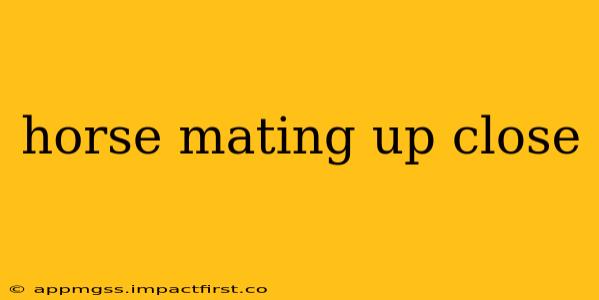Horse Mating: An Up-Close Look at Equine Reproduction
Horse mating, also known as equine breeding, is a fascinating and complex process. While we often see the results—foals—the act itself is rarely witnessed up close by the casual observer. This in-depth look explores the mechanics, timing, and considerations surrounding horse mating, addressing many common questions.
What is the process of horse mating like?
Horse mating can occur naturally, through pasture breeding, or artificially, through artificial insemination (AI). Natural mating involves the stallion and mare interacting directly. The stallion will typically exhibit courtship behaviors, such as sniffing the mare's urine and genitals, before attempting to mount. The act itself is relatively quick, lasting only a few seconds. Successful mating results in the stallion's sperm fertilizing the mare's egg.
Artificial insemination offers greater control over breeding, allowing for the selection of specific stallions regardless of location. This process involves collecting semen from the stallion and artificially inseminating the mare.
How long does horse mating last?
The actual act of mating is brief, usually lasting only a few seconds. However, the entire process, including courtship behaviors, can take several minutes. In natural mating, the stallion may attempt multiple mounts before successful copulation occurs.
How often do horses mate?
The frequency of mating depends on several factors, including the mare's estrous cycle (heat cycle) and the breeding goals. Mares are typically receptive to mating during estrus, which lasts for several days. Stallion behavior is also influenced by the presence of a receptive mare. In natural breeding situations, a stallion might mate multiple times during a mare's estrus.
What are the signs of a horse in heat?
Identifying when a mare is in heat (estrus) is crucial for successful breeding. Signs include:
- Frequent urination: Mares will urinate more often and in smaller amounts than usual.
- Winking: The vulva will exhibit rhythmic contractions, often referred to as "winking."
- Tail flagging: The mare will hold her tail to one side.
- Restlessness: Increased activity and pacing.
- Acceptance of mounting: A mare in heat will allow a stallion to mount her.
These signs are best observed by experienced horse handlers.
What is the gestation period for horses?
The gestation period for horses is approximately 11 months, or 335-345 days. This is a relatively long gestation period compared to some other mammals. Careful monitoring of the mare's health is crucial throughout this period.
How can I tell if my mare is pregnant?
Confirming pregnancy in mares requires veterinary expertise. Veterinarians use various methods, including rectal palpation (feeling the uterus through the rectum) and ultrasound, to detect pregnancy. These techniques allow for early diagnosis, typically within a month or two of conception.
What are some common problems associated with horse breeding?
Several factors can affect successful horse breeding. These include:
- Infertility: Both stallions and mares can experience infertility due to various reasons, including age, disease, or genetic factors.
- Breeding soundness examination: A veterinary examination assessing the reproductive health of both stallion and mare is vital.
- Timing: Precise timing of breeding, in relation to the mare's estrous cycle, is critical for successful conception.
Understanding the intricacies of horse mating requires a blend of observation, expertise, and respect for the animals involved. This information provides a foundational understanding; always consult with experienced equine veterinarians and breeders for guidance and support in breeding horses.
